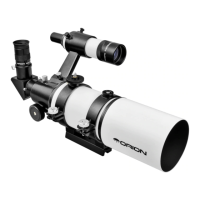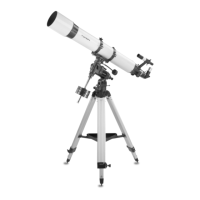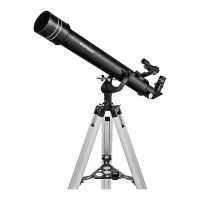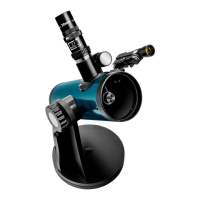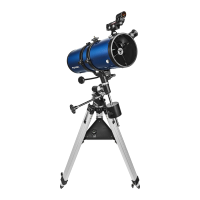5
about the right ascension axis. Rotate it until the counter-
weight shaft is parallel to the ground (i.e., horizontal).
2. Now loosen both counterweight lock knobs and slide the
weights along the shaft until they exactly counterbalance
the telescope (Figure 4a). That’s the point at which the shaft
remains horizontal even when you let go with both hands
(Figure 4b). If the telescope refuses to balance than you
have either too much or too little counterweight. Remove a
counterweight, or add optional counterweights if needed.
3. Retighten the counterweight lock knobs. The telescope is
now balanced on the right ascension axis.
4. To balance the telescope on the declination axis, first tight-
en the R.A. lock lever, with the counterweight shaft still in
the horizontal position.
5. With one hand on the telescope optical tube, loosen the
Dec. lock lever. The telescope should now be able to rotate
freely about the declination axis.
6. Loosen the knurled ring clamps on the tube rings a few
turns, until you can slide the telescope tube forward and
back inside the rings (this can be aided by using a slight
twisting motion on the optical tube while you push or pull
on it) (Figure 4c).
7. Position the telescope in the tube rings so it remains hori-
zontal when you carefully let go with both hands. This is the
balance point for the optical tube with respect to the Dec.
axis (Figure 4d).
8. Retighten the knurled ring clamps.
The telescope is now balanced on both axes. When you loos-
en the lock lever on one or both axes and manually point the
telescope, it should move without resistance and should not
drift from where you point it.
6. Setting Up and Using the
Equatorial Mount
When you look at the night sky, you no doubt have noticed
that the stars appear to move slowly from east to west over
time. That apparent motion is caused by the Earth’s rotation
(from west to east). An equatorial mount (Figure 5) is designed
to compensate for that motion, allowing you to easily “track”
the movement of astronomical objects, thereby keeping them
from drifting out of your telescope’s field of view while you’re
observing.
This is accomplished by slowly rotating the telescope on its
right ascension (R.A.) axis, using the built in motor drive. But
first the R.A. axis of the mount must be aligned with the Earth’s
rotational (polar) axis—a process called polar alignment.
Polar Alignment
For Northern Hemisphere observers, approximate polar align-
ment is achieved by pointing the mount’s right ascension axis
at the North Star, or Polaris. It lies within 1° of the north celes-
tial pole (NCP), which is an extension of the Earth’s rotational
axis out into space. Stars in the Northern Hemisphere appear
to revolve around the NCP.
To find Polaris in the sky, look north and locate the pattern of
the Big Dipper (Figure 6). The two stars at the end of the “bowl”
of the Big Dipper point right to Polaris.
Observers in the Southern Hemisphere aren’t so fortunate to
have a bright star so near the south celestial pole (SCP). The
star Sigma Octantis lies about 1° from the SCP, but it is barely
visible with the naked eye (magnitude 5.5).
For general visual observation, an approximate polar align-
ment is sufficient.
1. Level the equatorial mount by adjusting the length of the
three tripod legs.
2. There are two latitude adjustment L-bolts (see Figure 5);
loosen one while tightening the other. By doing this you
will adjust the latitude of the mount. Continue adjusting the
mount until the pointer on the latitude scale is set at the
latitude of your observing site. If you don’t know your lati-
tude, consult a geographical atlas to find it. For example, if
your latitude is 35° North, set the pointer to 35. The latitude
setting should not have to be adjusted again unless you
move to a different viewing location some distance away.
Figure 5. The Atlas EQ-G mount.
Dec. lock lever
(not shown)
Front opening
R.A. lock lever
Polar axis
finder scope
Latitude scale
Latitude
adjustment L-bolts
Azimuth
adjustment
knobs (2)
Declination
(Dec) axis
Right Ascension
(R.A.) axis
Figure 6. To find Polaris in the night sky, look north and find the
Big Dipper. Extend an imaginary line from the two “Pointer Stars” in
the bowl of the Big Dipper. Go about five times the distance between
those stars and you'll reach Polaris, which lies within 1° of the north
celestial pole (NCP).
Big Dipper
(in Ursa Major)
Little Dipper
(in Ursa Minor)
Cassiopeia
N.C.P.
Pointer
Stars
Polaris
